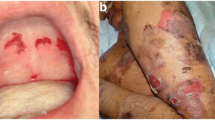Abstract
This chapter covers the history of pemphigus vulgaris, its effects, and development of treatment.
You have full access to this open access chapter, Download chapter PDF
Similar content being viewed by others
Keywords
Pemphigus was derived from the Greek word pemphix, which means vesicle or blister [1]. There are many different types of pemphigus, all involving vesicle formation at some stage, but the most common of all of them is pemphigus vulgaris. All types of pemphigus involve acantholysis , which means the breaking apart of intercellular connections through an autoantibody-mediated response. It was in 1964 that researchers first found that antibodies were responsible for breaking the intercellular connections between keratinocytes leading to this disease. Then, in 1971 through immunofluorescent staining, it was found that the body produces immunoglobulin G (IgG) autoantibodies against the intercellular substance that holds epithelial cells together.
Pemphigus vulgaris used to be an indefinitely fatal disease before the introduction of corticosteroids as the primary form of treatment in the 1940s [2]. Even though the mortality rate had decreased significantly with the help of corticosteroids, pemphigus vulgaris was still known as the fourth most common cause of death due to a skin disorder in 1998.
References
Cholera M, Chainani-Wu N. Management of pemphigus vulgaris. Adv Ther. 2016;33(6):910–58.
King DF, Holubar K. History of pemphigus. Clin Dermatol. 1983;1(2):6–12.
Author information
Authors and Affiliations
Rights and permissions
Copyright information
© 2018 Springer International Publishing AG
About this chapter
Cite this chapter
Mohammad Beigi, P.K. (2018). History of Pemphigus Vulgaris. In: A Clinician's Guide to Pemphigus Vulgaris. Springer, Cham. https://doi.org/10.1007/978-3-319-67759-0_3
Download citation
DOI: https://doi.org/10.1007/978-3-319-67759-0_3
Published:
Publisher Name: Springer, Cham
Print ISBN: 978-3-319-67758-3
Online ISBN: 978-3-319-67759-0
eBook Packages: MedicineMedicine (R0)




